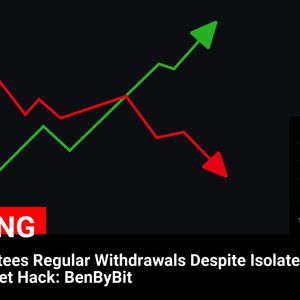Heads up, crypto traders and investors! All eyes are on the Reserve Bank of Australia (RBA) as they gear up for their first monetary policy decision of 2025. Whispers in the market strongly suggest a potential shift in strategy – a cut in interest rates. But what does this mean for the Australian Dollar, the broader economy, and even your crypto portfolio? Let’s dive deep into the anticipated RBA interest rate decision and what it could unleash. Why is the RBA Considering an Interest Rate Cut Now? For months, the RBA has held the Official Cash Rate (OCR) steady at 4.35%, battling stubbornly high inflation. However, the latest economic indicators are painting a slightly different picture. Inflation pressures in Australia appear to be easing, prompting speculation about a change in the RBA’s stance. Let’s break down the key factors influencing this potential shift: Easing Inflation: The most recent Consumer Price Index (CPI) data revealed a slower-than-expected rise in inflation during the final quarter of 2024. The RBA’s preferred measure, the Trimmed Mean CPI, also showed a moderation, hinting that previous rate hikes might be starting to bite. Economic Growth Concerns: While inflation remained elevated, the Australian economy has shown signs of sluggish growth. Persistent high interest rates can put a strain on households and businesses, potentially further dampening economic activity. A rate cut could be seen as a measure to inject some life back into the economy. Global Economic Uncertainty: The global economic landscape remains uncertain, with potential headwinds from international trade tensions and varying growth trajectories across major economies. A proactive move by the RBA could be aimed at safeguarding the Australian economy against external shocks. Despite these factors, it’s not a straightforward decision. Solid employment growth presents a counter-argument against aggressive rate cuts. The robust job market, with annual employment growth strengthening to 3.1% in December, suggests the economy isn’t in dire straits. This complexity adds an element of suspense to the upcoming RBA announcement. Decoding the Expected RBA Interest Rate Decision: 25 bps Cut on the Horizon? Market consensus strongly leans towards a 25 basis points (bps) cut to the OCR. This expectation is built upon: Inflation Data: As mentioned, the latest CPI figures provided a crucial signal that inflation might be on a downward trajectory. The Trimmed Mean CPI coming in below expectations was a significant factor. RBA’s Own Signals: Recent statements from the RBA, particularly the minutes from previous meetings, suggest a subtle shift in tone. While initially emphasizing upside risks to inflation, the RBA has more recently expressed “some confidence” that inflation is moving towards their 2-3% target range. Market Pricing: Financial markets have already priced in a high probability of a 25 bps cut, indicating a strong conviction among investors and analysts. However, it’s crucial to remember that central bank decisions are never guaranteed. The RBA could still opt to hold rates steady, or even surprise the market with a larger 50 bps cut if they are deeply concerned about economic slowdown. The actual statement accompanying the decision will be just as important as the rate move itself, offering crucial clues about the RBA’s future policy path. How Will an AUD Interest Rate Cut Impact the Australian Dollar? A cut in interest rates generally tends to weaken a currency. Therefore, if the RBA delivers the expected 25 bps interest rate cut, the Australian Dollar (AUD) could face selling pressure. However, the extent of the AUD’s weakness will depend on several factors: Magnitude of the Cut: A 25 bps cut is largely priced in. A surprise 50 bps cut would likely trigger a more significant AUD sell-off. Forward Guidance: The RBA’s statement and Governor Bullock’s press conference will be critical. If the RBA signals further rate cuts are likely in the near future (a dovish stance), the AUD could weaken considerably. Conversely, if they emphasize a cautious approach to easing, suggesting spaced-out cuts (a hawkish cut), the AUD’s downside might be limited, or it could even see a temporary bounce. Global Context: The performance of the US Dollar (USD) and overall market sentiment will also play a role. If the USD remains weak, as suggested by recent market trends influenced by US fiscal policy and Federal Reserve expectations, the AUD/USD pair might see limited downside even with an RBA rate cut. Valeria Bednarik, Chief Analyst at Bitcoin World, offers a technical perspective on the AUD/USD pair: “The AUD/USD pair has shown bullish momentum, reaching its highest level since mid-December. Technically, there’s scope for further gains towards the 0.6470 region if the pair can overcome immediate resistance at 0.6373. However, a dovish RBA outcome could trigger a slide below 0.6300, potentially exposing the 0.6230 zone.” What are the Broader Economic Implications of RBA’s Decision? Beyond the immediate impact on the Australian Dollar, the RBA’s interest rate decision has wider implications for the Australian economy: Borrowing Costs: A rate cut would reduce borrowing costs for households and businesses, potentially stimulating spending and investment. This could provide a welcome boost to economic growth. Housing Market: Lower interest rates can fuel demand in the housing market, potentially leading to increased property prices. This can be a double-edged sword, offering wealth effects for homeowners but also raising concerns about housing affordability. Inflation Expectations: The RBA needs to carefully manage inflation expectations. While aiming to ease current pressures, they must avoid signaling a premature victory over inflation, which could lead to a resurgence in price increases down the line. Savings and Investments: Lower interest rates can reduce returns on savings accounts and fixed-income investments, potentially encouraging savers to seek higher-yielding assets, including riskier investments. Navigating the Forex Market After the RBA Rate Cut: Key Strategies For Forex traders, the RBA interest rate decision presents both opportunities and risks. Here are some key strategies to consider: AUD/USD Trading: Monitor the AUD/USD pair closely around the announcement. A dovish RBA outcome could present short-selling opportunities, while a hawkish cut might offer long opportunities if the pair breaks above resistance levels. Cross-Currency Pairs: Consider trading AUD against other currencies, such as the Japanese Yen (JPY) or the Euro (EUR). The relative monetary policy stances of these central banks compared to the RBA will be crucial in determining cross-currency movements. Risk Management: Volatility is likely to spike around the RBA announcement. Employ robust risk management techniques, including stop-loss orders and appropriate position sizing, to protect your capital. Stay Informed: Keep abreast of the latest news and analysis from reputable sources like Bitcoin World to stay ahead of market developments and refine your trading strategies. RBA FAQs: Understanding the Basics Let’s address some frequently asked questions about the RBA and its influence: What is the Reserve Bank of Australia and how does it influence the Australian Dollar? The Reserve Bank of Australia (RBA) is Australia’s central bank. It sets interest rates and manages monetary policy to maintain price stability (inflation between 2-3%) and contribute to the stability of the currency, full employment, and economic prosperity. Higher interest rates generally strengthen the AUD, while lower rates tend to weaken it. How does inflation data impact the value of the Australian Dollar? Moderately higher inflation can lead central banks like the RBA to raise interest rates to control prices. Higher rates attract foreign investment, increasing demand for the AUD and thus its value. Conversely, very low inflation or deflation can signal economic weakness and potentially lead to rate cuts, weakening the AUD. How does economic data influence the value of the Australian Dollar? Strong economic data (e.g., GDP growth, strong employment, positive PMIs) suggests a healthy economy, attracting investment and potentially leading to higher interest rates by the RBA. This generally strengthens the AUD. Weak economic data can have the opposite effect. What is Quantitative Easing (QE) and how does it affect the Australian Dollar? Quantitative Easing (QE) is an unconventional monetary policy tool used in crises. The RBA prints AUD to buy assets (usually government bonds) to inject liquidity into the financial system. QE typically weakens the AUD as it increases the supply of the currency. What is Quantitative tightening (QT) and how does it affect the Australian Dollar? Quantitative Tightening (QT) is the reverse of QE. The RBA reduces its balance sheet by stopping asset purchases and allowing bonds to mature without reinvesting. QT is usually implemented during economic recovery to combat inflation and is considered bullish for the AUD as it reduces currency supply. Economic Indicator: RBA Trimmed Mean CPI (QoQ) The Trimmed Mean CPI is a key inflation gauge for the RBA. It measures the change in prices of a basket of goods and services, excluding the most volatile components to provide a clearer picture of underlying inflation trends. A higher reading is generally AUD bullish, suggesting potential rate hikes, while a lower reading is AUD bearish, potentially leading to rate cuts. Last Release: Wed Jan 29, 2025 00:30 Frequency: Quarterly Actual: 0.5% Consensus: 0.6% Previous: 0.8% Source: Australian Bureau of Statistics Why it matters to traders? The CPI data is crucial for traders as it directly influences RBA policy decisions and the AUD’s valuation. Rising consumer prices can lead to RBA rate hikes, making the AUD more attractive to investors. Conclusion: Brace for Potential Australian Dollar Volatility The upcoming RBA interest rate decision is a crucial event for the Australian Dollar and the broader financial markets. While a 25 bps cut is widely anticipated due to easing inflation pressures, the RBA’s forward guidance and any surprises in the announcement will be key drivers of market reaction. Traders should prepare for potential volatility in the AUD and adjust their strategies accordingly. Keep a close watch on the RBA’s statement and Governor Bullock’s press conference for vital clues about the future path of Australian monetary policy and its impact on the Forex landscape. To learn more about the latest Forex market trends, explore our article on key developments shaping interest rates and institutional adoption in the forex-news category here .



















